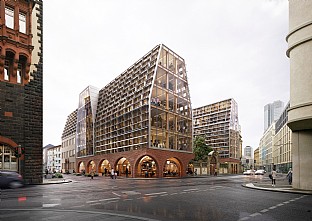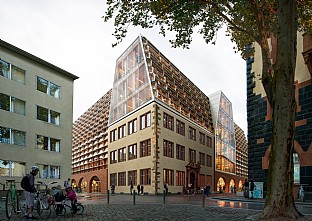Urban accents
The resulting R-shape of the wings rotated around the courtyard refers to both the perimeter block and the row typologies of the surrounding urban fabric, as a historical-contextual but also independent reinterpretation of the original large baroque form. The only surviving exterior facade of the baroque wing will be integrated into the new building along with the historic cellar and the arched gateway to the main courtyard. The sloping upper floors with shading PV slats and transparent gable surfaces form an urban accent and reaction to the surrounding roof landscape. The ground floor as a semi-public, permeable structure with cafe, conference, retail and exhibition areas serves as a link to the city, where employees and passers-by meet, and is designed as a spatial vaulted structure of concrete arches covered with recycled bricks from the existing building. The upper floors are designed as a light and rational timber-hybrid structure and can be used flexibly for different office layouts including both multi-tenant and single-tenant scenarios.
Central atrium as a communications hub
The central space created by the rotation of the wings is covered with a glass roof and functions as an internal atrium, where materials and components from the existing building are reused and exposed. A cascade of stairs connects the ground floor with the upper floors and accesses the individual office units. This atrium as a 'heart space' is a central communication hub for informal exchange and meetings and promotes an open networking culture.






